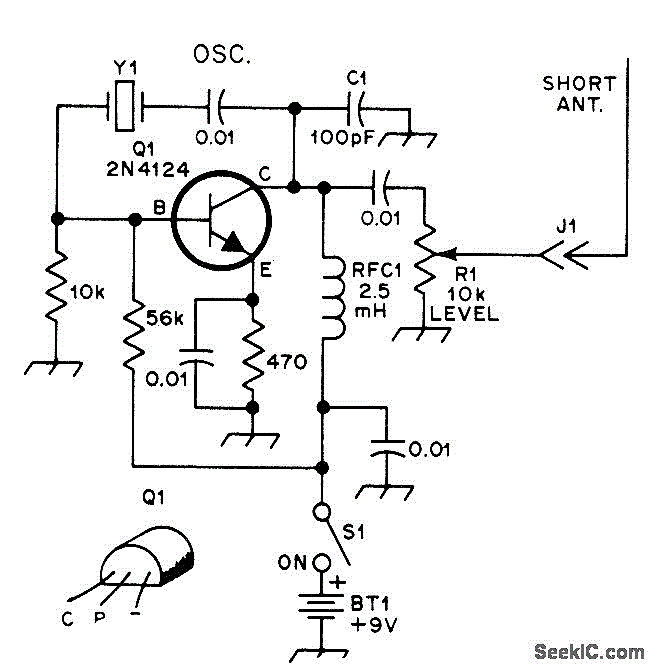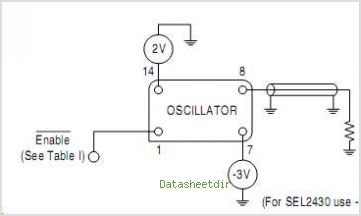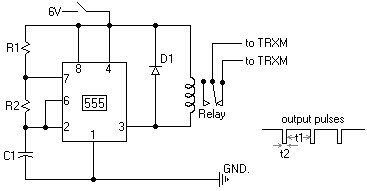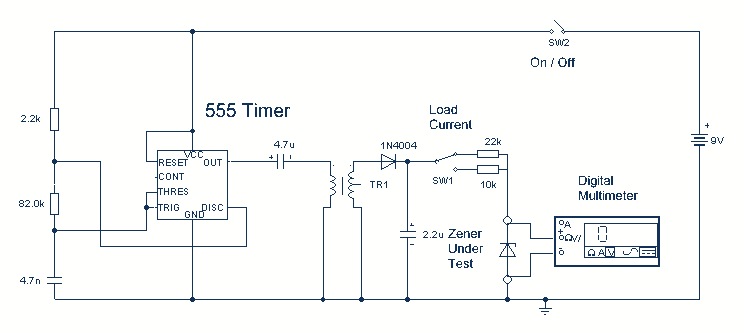
UNIVERSAL TEST OSCILLATOR

The crystal is positioned in the feedback path of a Pierce oscillator, situated between the base and collector of transistor Q1, with a 2.5 mH RF choke replacing the tuned collector circuit. The oscillator operates within a frequency range of 400 kHz to 20 MHz, contingent upon the crystal used. It is designed for fundamental frequency crystals; however, third overtone types will also oscillate but at their fundamental frequency. The value of the capacitor C1 is set for 1 MHz and higher frequencies; for lower frequencies, it should be increased to 330 pF.
The Pierce oscillator circuit is a popular configuration for generating stable sine wave signals, particularly in RF applications. In this configuration, the crystal acts as a frequency-determining element, providing a high degree of stability and precision to the output frequency. The placement of the crystal in the feedback loop between the base and collector of the transistor Q1 ensures that the oscillator can sustain oscillations at the desired frequency.
The use of a 2.5 mH RF choke in place of a tuned collector circuit is critical for impedance matching and minimizing loading effects on the oscillator. The choke serves to block RF signals while allowing DC biasing to the transistor, which is essential for proper operation. The choke's inductance value must be chosen carefully to ensure that it does not resonate with the crystal at the intended operating frequencies.
The oscillator's frequency range from 400 kHz to 20 MHz is determined by the characteristics of the crystal used. Fundamental frequency crystals are preferred for their performance, as they provide a more predictable oscillation frequency. In contrast, third overtone crystals may still function but will do so at the fundamental frequency, which may not be suitable for applications requiring higher frequencies.
Capacitor C1 plays a vital role in tuning the oscillator's frequency. For applications operating at 1 MHz and above, the specified value of C1 is adequate. However, for lower frequency applications, increasing the capacitance to 330 pF is recommended to maintain stable oscillation and ensure that the circuit operates effectively within the desired frequency range.
Overall, the Pierce oscillator configuration with a crystal in the feedback path is a robust solution for generating precise frequencies in electronic circuits, particularly in communication and signal processing applications. Proper selection of components and careful design considerations are essential for achieving optimal performance.Crystal is in feedback path of Pierce oscillator, between base and collector of al, with 2.5-mH RF choke in place of tuned collector circuit. Oscillator works from 400 kHz to 20 MHz, depending on crystal. Designed for fundamental crystals; third overtone types will oscillate but at fun-damental. Value of 01 is for 1 MHz and higher; increase to 330 pF for l.. 🔗 External reference
The Pierce oscillator circuit is a popular configuration for generating stable sine wave signals, particularly in RF applications. In this configuration, the crystal acts as a frequency-determining element, providing a high degree of stability and precision to the output frequency. The placement of the crystal in the feedback loop between the base and collector of the transistor Q1 ensures that the oscillator can sustain oscillations at the desired frequency.
The use of a 2.5 mH RF choke in place of a tuned collector circuit is critical for impedance matching and minimizing loading effects on the oscillator. The choke serves to block RF signals while allowing DC biasing to the transistor, which is essential for proper operation. The choke's inductance value must be chosen carefully to ensure that it does not resonate with the crystal at the intended operating frequencies.
The oscillator's frequency range from 400 kHz to 20 MHz is determined by the characteristics of the crystal used. Fundamental frequency crystals are preferred for their performance, as they provide a more predictable oscillation frequency. In contrast, third overtone crystals may still function but will do so at the fundamental frequency, which may not be suitable for applications requiring higher frequencies.
Capacitor C1 plays a vital role in tuning the oscillator's frequency. For applications operating at 1 MHz and above, the specified value of C1 is adequate. However, for lower frequency applications, increasing the capacitance to 330 pF is recommended to maintain stable oscillation and ensure that the circuit operates effectively within the desired frequency range.
Overall, the Pierce oscillator configuration with a crystal in the feedback path is a robust solution for generating precise frequencies in electronic circuits, particularly in communication and signal processing applications. Proper selection of components and careful design considerations are essential for achieving optimal performance.Crystal is in feedback path of Pierce oscillator, between base and collector of al, with 2.5-mH RF choke in place of tuned collector circuit. Oscillator works from 400 kHz to 20 MHz, depending on crystal. Designed for fundamental crystals; third overtone types will oscillate but at fun-damental. Value of 01 is for 1 MHz and higher; increase to 330 pF for l.. 🔗 External reference





